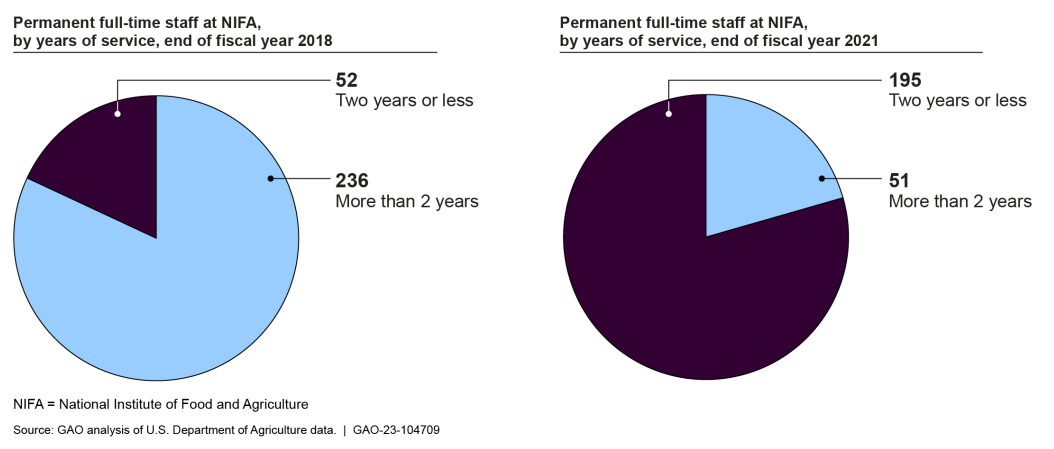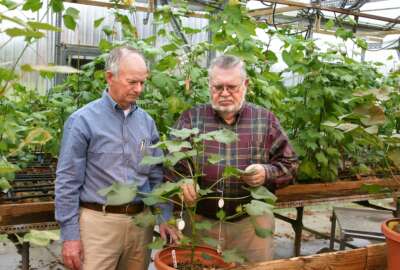USDA has recovered from attrition, but new research staff is less diverse, less experienced
The Agriculture Department has restored staffing levels after attrition following 2019 research facility relocations, but the new workforce has overall less job...
It took the Agriculture Department two years to recover from mass staff attrition in 2019, but the agency is still facing challenges from the decision to relocate two of its major research facilities.
The larger problem now, beyond successfully restaffing the Economic Research Service and the National Institute of Food and Agriculture, is dealing with a loss of employee experience and staff diversity, according to a Jan. 13 report from the Government Accountability Office.
“Prior to the relocation, 80% of the folks at both agencies had two or more years’ experience. After the relocation, it was essentially a flip of that,” GAO Director of Natural Resources and Environment Steve Morris said in an interview with Federal News Network. “There were a lot of new people coming on board. There was a loss of experience and seniority.”
The number of employees with fewer than two years of experience drastically increased between fiscal 2018 and 2021. At ERS, the percentage of employees with more than two years of experience dropped from 84%, down to 34%. For NIFA, the disparity was even greater — going from 82% to 21%.

In terms of staff diversity, Morris said the rehiring efforts were in some ways a “missed opportunity.”
“Neither ERS nor NIFA really did a good job of focusing on things that would enhance their management of diversity. They didn’t have standards in place. They didn’t articulate efforts related to recruiting and training,” he said.
Notably, the percentage of Black employees at NIFA dropped from 47% prior to the move, to 19% currently. At ERS, the percentage of Black employees between 2018 and 2021 decreased from 22% to 9%. In contrast, white employees now comprise a much larger portion of both agencies’ workforces.

The relocation during the Trump administration moved both ERS’ and NIFA’s headquarters from Washington, D.C., to Kansas City, Missouri. The decision was in response to a presidential initiative to move many federal agency headquarters outside the nation’s capital. At the time, USDA said the goals of relocating the two research centers were to recruit and retain a highly qualified workforce, and to accrue more cost savings with a cheaper lease.
But in the two years after relocating, ERS and NIFA’s workforce size and productivity both declined significantly. In total, about 121 full-time employees left ERS, and 157 left NIFA, as a result of the move.
“Before [the relocation], ERS and NIFA had about 300 staff. At its peak, [the workforce] declined by half,” Morris said. “Productivity followed along the same lines.”
Many of the positions that lost employees were central to the agency’s functions, including economists, managers and supervisors. Losing leadership made it especially difficult for the agencies to make decisions on hiring overall.
“When you lose that number of people, there’s so much that’s lost — the institutional knowledge, the ability to offer services. People don’t necessarily feel good about their environment,” USDA Deputy Secretary Jewel Bronaugh told Federal News Network in October.
As a direct result of the staff loss, ERS produced fewer key reports, and NIFA took longer to process grants, the GAO report found. For ERS, the number of research reports and journal articles that staff issued during that time period dropped off by about half.
But after two years, as more new employees came on board, the agencies both largely recovered their productivity levels.
“[ERS and NIFA] took a similar significant hit in terms of processing time. But when you look at it two years later, that processing time continues to improve, recovering from where it was before,” Morris said. “I think part of this is a testament to the agencies, that they were able to get people on board to do the important work that they have to do.”
Part of rebuilding staff also changed as a result of the COVID-19 pandemic. As the agencies were in the middle of restaffing, they shifted to allow some positions to have a “negotiable duty station,” meaning moving to Kansas City wasn’t a requirement for every position, the GAO report said. Offering remote job opportunities gave the two agencies a little more flexibility as they were hiring new employees.
“USDA utilized direct hiring authority and was able to bring folks on board outside of the Kansas City location in some cases, and also provide telework opportunity for folks in Kansas City and D.C.,” Morris said. “The use of those flexibilities in hiring did help the agencies in terms of bringing folks on board.”
The GAO report is the second that the agency has issued on the relocation. The first report, published last April, found that although USDA had a clear process for making relocation decisions, that process didn’t account for the cost of staff attrition that could result from moving a federal facility.
During the mass rehiring initiative between 2019 and 2021, both ERS and NIFA largely failed to follow best practices for effective agency reforms and workforce management, the new GAO report found. For example, the agencies didn’t follow leading practices around diversity management. Additionally, the department didn’t formally document its planning process for long-term staffing needs and goals.
In particular, ERS and NIFA didn’t have adequate recruitment processes for bringing in diverse candidates, either before or after the relocation, the report said.
“We’re trying to get USDA to be a little bit more forward-thinking,” Morris said. “USDA really didn’t consider the impact of attrition, and what that might mean in terms of diversity. That’s one thing they should consider, especially moving forward.”
USDA also didn’t much involve employees, stakeholders or Congress in the decision-making process, the report said.
“There was a bit of a vacuum there in terms of getting input on the relocation,” Morris said.
There were a couple positive actions that USDA took, though. For instance, the department did monitor the impacts of the relocation, the GAO report said.
“By more fully following these leading practices as the agencies continue to rebuild their workforces, ERS and NIFA will be better positioned to address the impact of the recent relocation and any future relocations,” the report said. “Following these practices will also help agencies support workforce training needs and strategically plan for changes in their workforce composition.”
USDA said it generally agreed with the recommendations in the report. ERS and NIFA are now taking steps to proactively address GAO’s recommendations around strategic workforce planning.
“We believe it is up to USDA management to set expectations for the agencies to more fully follow these leading practices,” the report said.
Copyright © 2025 Federal News Network. All rights reserved. This website is not intended for users located within the European Economic Area.
Drew Friedman is a workforce, pay and benefits reporter for Federal News Network.
Follow @dfriedmanWFED




